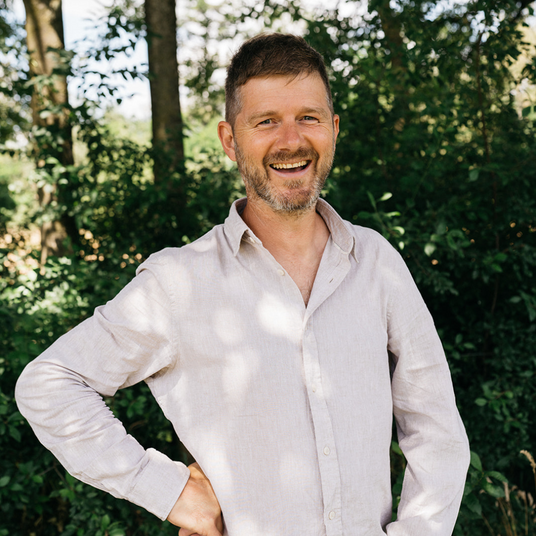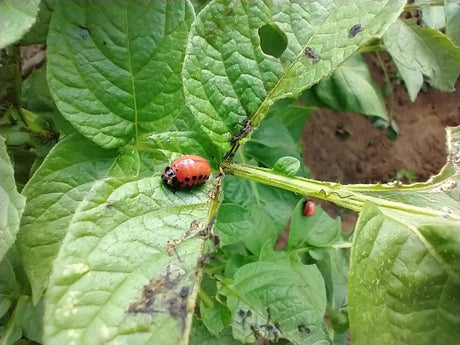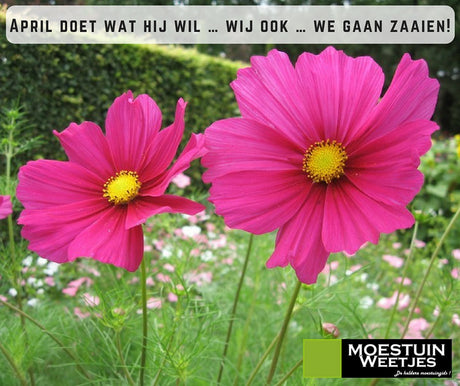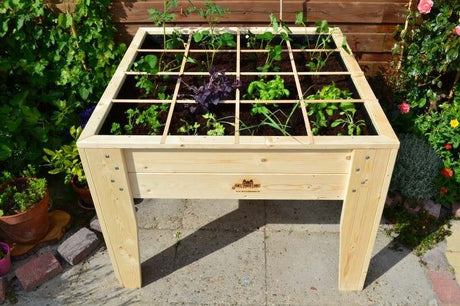Quick start ⚡ Quick start info for sowing courgettes ⚡
🌱 Sowing & planting
- Latin name: Cucurbita pepo
- Sowing depth: 2.5 cm
- Pre-sowing: in 8 cm pots (indoors or under glass)
- Germination temperature: ± 18 °C
- Germination period: 7–12 days
- Planting distance: 80 cm around the plant
- Growth cycle: ± 100 days
- Plant out: when there are 4 true leaves
📅 Growing times
- Early: Sow indoors mid-April–end of April or plant under glass in May; plant outdoors mid-May–mid-June; harvest July–September.
- Late: sow outdoors mid-May–June; harvest late July–early October.
Courgette is a heat-loving plant: wait to plant out until after the risk of night frost.
📘 Basic information
- Crop group: Fruit crop
- Crop family: Cucumber family (Cucurbitaceae)
- Height: 30–60 cm (wide-growing plant)
- Frost resistant: no
- Root system: ± 30–45 cm deep
- Fertilization: a lot compost
- Preferred soil: pH 5.7–7.5
🌞💧 Pitch & water
Location: ☀☀☀ lots of sun.
Watering: 💧💧 Water moderately to generously, especially during flowering and fruiting.
🤝 Good & Bad Neighbors
- Good neighbors: nasturtium, corn, marigold, onion, sunflower, melon, pumpkin, radish, garlic, beans, coin, dill
- Bad neighbors: potato
🧑🌾 Cultivation method step-by-step
- Sow indoors mid-April–end of April in 8cm pots at a depth of 2.5cm.
- Germinate at ±18 °C and keep the soil slightly moist.
- Plant out from mid-May (after frost) with approximately 80 cm around each plant.
- For a late crop, you can sow directly outdoors from mid-May.
- Provide generous amounts of compost and sufficient water during growth and fruiting.
- Harvest regularly, preferably when the fruits are still young and tender.
❗ Dangers & Concerns
- Snails: eat young leaves and fruits.
- Mildew: white, powdery mold on the leaves, especially in dry weather with a lot of dew.
🧺 Harvesting & storing
- Harvest when the fruits are nicely shaped but still tender.
- For culinary delights, harvest when the flower is still attached to the fruit (the flower is also edible).
- For soup you can let them grow bigger.
🍽️ Nutritional value
Per 100 g raw zucchini with skin:
- 16 kcal
- 0 g fat
- 3 g carbohydrates
- 1 g protein
- 1 g fiber
- 2 g sugar
- Vitamins: A, B6 and C
- Other: thiamin, niacin, copper, riboflavin, magnesium, phosphorus, folic acid, manganese and potassium
Table of Contents:
Zucchini is known for its enormous productivity—with just two or three plants, an average family can eat zucchini all summer long. Read on to discover how to grow your own zucchini, from sowing one or two seeds to harvesting kilos of zucchini all summer long.
General information about courgettes
Courgettes are warm-season crops and come in a variety of colors and shapes. You can choose from compact, bushy, or trailing varieties. Compact varieties are ideal for pots —basically anywhere where space is limited—while trailing varieties can be trained as climbers to grow on supports like trellis or wire mesh.
Green zucchini are always popular, but also try some of their more charismatic cousins, including varieties with yellow berries, striped or ribbed berries, and even round ones. The Striato 'D'Italia' is my personal favorite; it's a very firm and flavorful zucchini (the third in the list above).
The best place to grow your courgettes:
Zucchini belongs to the pumpkin family, so to thrive, they need warmth and sunshine. Protect them from strong winds, too, so bees and other insects can pollinate the flowers in peace.
Their robust growth and large leaves make them ravenous eaters. Add plenty of garden compost or well-rotted manure to the soil before planting. You can even plant zucchini on top of a compost pile if you don't need the compost until the fall.
How do you sow zucchini?
You can sow zucchini directly outdoors after the last frost date (after May 15th). Dig a hole in the soil about 1 cm deep and plant two seeds in it. Cover them again and place a bell jar over the top to serve as a miniature greenhouse to speed things up. Once the seedlings emerge, remove the weakest ones so that only one remains in each spot. Direct sowing this way works well, but I prefer to get a head start by sowing a few weeks earlier in the greenhouse or indoors (around mid-April).
Fill P9 pots with potting soil and sow one seed per pot. Place the seed on its side. They germinate fastest in a little warmth, but as long as you can guarantee a frost-free environment, they will germinate. At room temperature, the seeds take about 7 to 12 days.
In the video below, Tom shows you how to sow zucchini. He uses a tray with large plugs and later, once each seedling has a second set of leaves, transplants them into a P9 pot. You can plant your zucchini outdoors from mid-May onwards.
Growing zucchini vertically
Looking for a challenge or do you have a smaller vegetable garden? Then I recommend the Black Forest climbing zucchini. I grew it in my garden using the rose arch combined with a support net. This creates a trellis and allows you to grow other crops under the rose arch, such as lettuce , lettuce , spinach , etc. These plants appreciate a little shade in the summer.
How and when to plant zucchini?

Plant zucchini out as soon as the risk of night frost has passed (around mid-May). Prepare plants for outdoor life by gradually acclimating them for one to two weeks beforehand. Start by placing them outside in a sheltered spot for a while during the day, then gradually increase the amount of time they're outdoors. Plant them out as soon as there's no risk of frost. This process is called hardening off.
Planting couldn't be easier. Dig a hole twice as wide and deep as your P9 pot in the prepared soil. Remove the young plant from its pot. Place it in the hole and fill it back up with soil. Finally, water thoroughly. Leave a 1-meter gap between each plant.
Growing zucchini: tips for caring for your plant
Once you've planted your zucchini, it's simply a matter of taking good care of it. In return, you'll get zucchini all summer long, and often a large number in the fall.
Water your zucchini well and occasionally add some mulch to help retain moisture in the soil for longer.
Plants tend to produce only male flowers initially, and pollination can be slow to get going anyway, especially in cool or damp weather. If there are few pollinating insects on the ground—or rather, in the air—you can hand-pollinate flowers by transferring pollen directly from a male flower to an open female flower.

Growing zucchini: male and female flowers
The flowers are also delicious to eat, usually stuffed or simply dipped in batter and then fried. But only pick the male flowers, otherwise you won't get any fruit!

Mildew on zucchini
Powdery mildew can be a problem on the leaves later in the season. By watering the plants well and leaving plenty of space between them for good air circulation, you can slow the spread of this disease. If your zucchini gets powdery mildew, there's no need to worry too much, as the plants can usually handle it.
Important note: Some zucchini varieties have color variations on their leaves. This is therefore not powdery mildew. You can recognize powdery mildew by a white, powdery layer that spreads over the entire plant, especially on top of the leaves. Downy mildew is less common and most prevalent in cool, moist conditions when the foliage can't dry.
Do you see any affected leaves? Cut them off. You can also prune away older leaves (which will turn brown anyway once they've given up all their energy). This keeps the plant healthy.
Your plant will usually recover quite quickly. If you notice your plant is suffering from powdery mildew, you can opt to treat it with a fungicide (anti-fungal product).
How to harvest zucchini?
Start cutting or turning zucchini when the fruits are still small. Smaller fruits have a denser, nuttier flesh and, believe me, are much better tasting. If you've ever turned off zucchini, it's probably because you let them grow into large, watery zucchini full of large seeds. Check the plants often—at least every other day—and pick the fruits as soon as they reach a usable size.
Finally, about growing zucchini
So, that's all I know about growing zucchini. Hopefully, you'll find these tips helpful and harvest kilos of zucchini yourself.
Did you find this article valuable? Then consider buying your zucchini seeds and other materials from our webshop. We'd really appreciate it.
Warm greetings, Sarah














